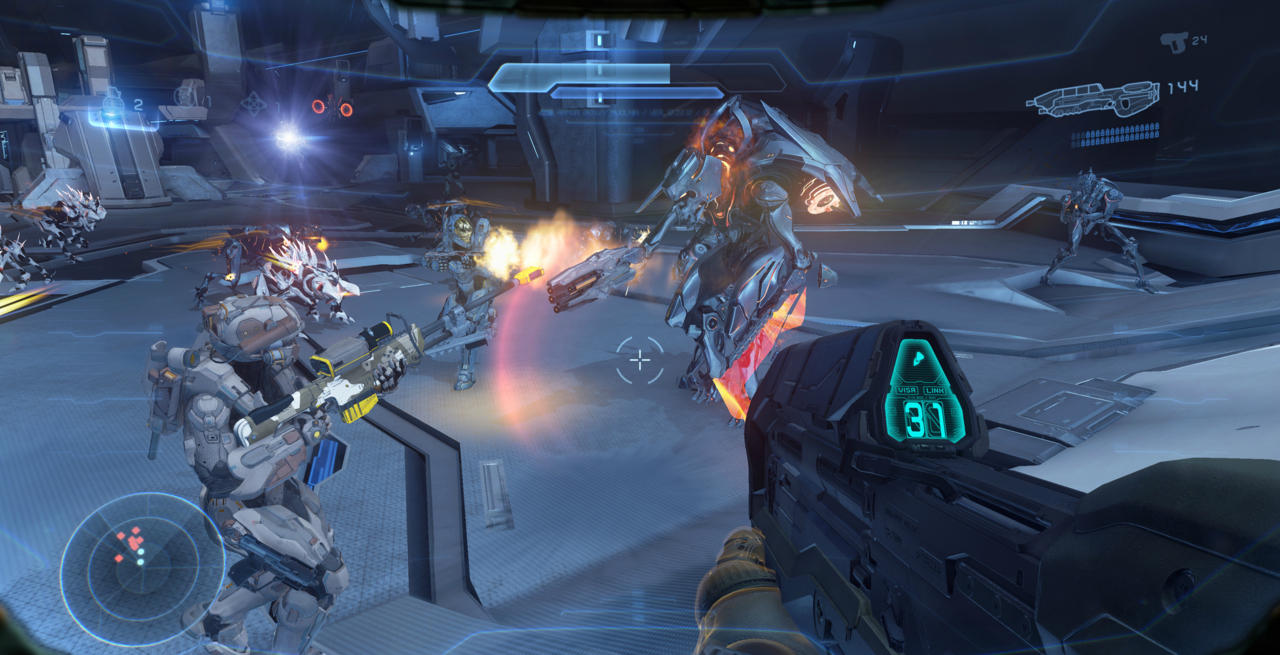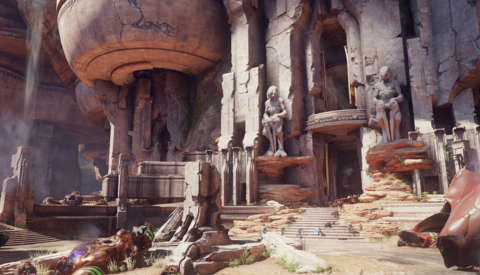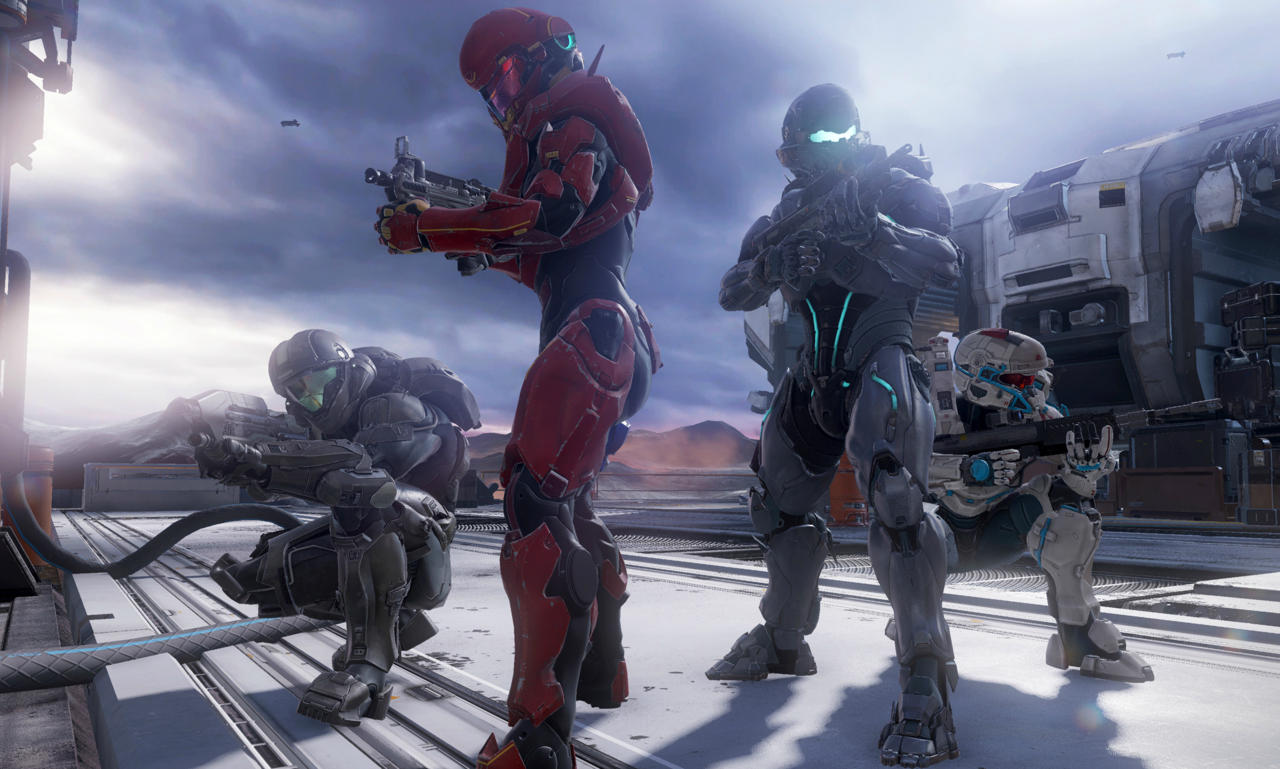Halo 5: Guardians is fueled by new ideas and propelled by some of the boldest changes to this storied franchise yet. Some of these changes fail, but others succeed, and although Halo 5 falters at times, it whisks us through black holes and across war torn tropical islands at a rapid pace. We can only surrender to its velocity.
With Halo 5, developer 343 Industries comes closer to meeting the many expectations the Halo name carries with it. This is only the developer's second original title, but some facets of the franchise's formula are at their best here. Guardians introduces new player movement, open level design, and an innovative new multiplayer mode, all to great effect. It also implements a new campaign structure, with eight playable characters across two separate teams, as one chases the other across the universe.
On the one hand, you have Blue Team, comprising the Chief and three of his oldest Spartan comrades. On the other, you have Team Osiris, four soldiers new to the Spartan program, still learning each other's idiosyncrasies. Blue Team's Kelly and Fred speak in short sentences and knowing responses. Osiris is less familiar: Edward Buck's humor often comes during awkward pauses, while Tanaka reveals more about her past than the others asked for.
This learning process aids us well, though, as we're newcomers too. It's fascinating to hear why Vale knows Sangheili, the language of the Covenant Elites. It's intriguing to catch glimpses of Locke's shady past. We're participating in the gameplay, yes, but we are still observers. In granting us these brief glimpses, 343 lends genuine personality to these soldiers.

The Spartans' relationships unfold across what amounts to an extended chase sequence: the Master Chief is suspected of war crimes, so Locke and his team are ordered to bring him in. It's a bold thing, turning the face of your franchise into a possible villain. But it sets the stage for what could be an intriguing character study. Sadly, though, it never delivers.
Halo 5 pulls us through this chase as it tries to tell a story about responsibility, the nature of artificial intelligence, and the fall of one's idols. But while there might be a compelling story to tell here, Halo 5 doesn't make use of the opportunities available. Cutscenes fade to black before they feel finished. Character motivations shift on a whim. Halo 5: Guardians spans several beautiful worlds, with chromatic mushroom fields and labyrinthine cave networks, but I seldom knew why I was there.
343 devotes almost 30 seconds to a tangential rant by a ship's AI, but it can't clearly explain where I'm going. The ending is also weak, and although it's the second installment in a trilogy, it still ended during what seemed like the story's climax. Despite the frenetic pace of its gameplay, the campaign loses impact when there's not much story to contextualize missions

There are also combat-free environments in Halo 5's campaign, in which you explore small, self-contained areas before embarking on the next mission.You can speak with Dr. Catherine Halsey, the founder of the UNSC Spartan program. You chat with friendly alien grunts as they sing, banter, and argue in their boredom. There are also audio logs scattered throughout the campaign, containing overheard whispers and fleeting conversations that, at their best, help flesh out Halo 5's backstory.
But these sections don't fit. They're added weight to an already disjointed plot. The exploration-based areas and diary entries only serve to slow down the otherwise steady sprint through Halo 5's worlds, and I moved past them in an effort to keep the experience moving.
But in the end, my frustration with the campaign's narrative was offset by how good the gameplay feels. 343 has added several abilities to the usual Spartan skillset, granting new options to the already tight controls. You can ground pound unsuspecting enemies from above. You can dash to one side to avoid that rocket barrelling past your team. The Smart Link--a neural interface that grants a zoom ability with every weapon--lets you hover mid-air as you line up a shot. Now more than ever, I actually feel like a super soldier.
That 343 has introduced these drastic changes to the formula, while still maintaining that responsive Halo feel, is admirable. As a Halo veteran, this feels like I remember, but also adds another layer of nuance to my muscle memory. Halo 5 introduces a new kinetic vocabulary that's not essential to survival, but it certainly helps.
Now more than ever, I actually feel like a super soldier.
You can also finish sprints with a brutal melee smash. While this is useful for depleting Elites' shields, or sending grunts careening across the map, it also opens up side routes through Halo 5's open-ended mission layouts. Gone are the linear pathways of the series' past: these new environments function more as arenas, with varying elevations and avenues of approach. There are also hidden weapon stashes and vehicle depots. If you don't mind the erratic narrative, these missions are worth replaying, just to see them unfold differently a second time.
Halo 5 is best played cooperatively, though, with three friends. The ability to split into two teams, cover each other from different angles, and utilize every weapon possible leads to a wide array of emergent gameplay situations. One of my favorite missions places two players in Forerunner phaeton ships while the other two progress on the ground. The foot soldiers concentrated on enemy ground troops, while the pilots destroyed imposing laser turrets. The juxtaposition of aerial and foot combat, and the interplay between them, is Halo 5 at its best.
Four-player co-op also erases the weight of the ally AI, which fills any spots devoid of a human player. To be fair, the AI performs well at times: after pointing out a priority enemy target, my artificial teammates are quick to focus their fire. But other times, the AI is abysmal. Halo 5 grants you a second chance before forcing a respawn, allowing your teammates to revive your dying character. And this works well in co-op, when two players can provide cover fire as the third rushes to the rescue. But without a human touch, this situation devolves into a train of suicide missions as the AI rushes into certain death, one by one.

Yet despite the inconsistent AI, and despite its incomprehensible plot, this is a fast-paced campaign with smart level design and fluid gameplay. At its best, the shooter rewards teamwork between four friends, encourages clever use of its new movement system, and unfolds across a variety of gorgeous worlds. By the end, however, it drags us through a convoluted plot with poor storytelling.
But then there's the multiplayer. And here, Halo 5 excels. In fact, this is the best shape Halo's multiplayer has ever taken.
The classic Halo playlists, such as Slayer, Capture the Flag, and the fan-favorite SWAT, eschew the modern multiplayer progression system introduced with Halo 4. Now, instead of earning new weapon options a la Call of Duty, Halo 5 returns to form with universal weapon loadouts, and by scattering power weapons throughout each map, delivers a welcome departure from the tedious unlock system of its predecessor.
You won't develop the necessary competitive reflexes over the course of a single match. Arena will make sense right away, but multiplayer skill comes with practice. When practice feels this fluid, though, and movement this dynamic, acquiring those skills isn't a chore.
This is the best shape Halo multiplayer has ever taken.
While Arena feels great in a tactile sense, and captures the essence of what makes Halo multiplayer compelling, Halo 5's new Warzone departs from franchise tradition several times over. It takes inspiration from the MOBA genre, combining player vs. player tactics with player vs. environment combat. And it's one of the best new ideas in not just this series, but the shooter genre in general.
Warzone spans huge maps, in lush jungles and barren arctic landscapes. Each team has a plethora of options laid out before it, from capturing neutral zones, to killing enemy players, to defeating AI combatants. Several times throughout each match, AI mini-bosses will spawn. These opponents pilot Banshee fighter ships and drive Wraith tanks, and present a greater challenge than the normal AI fodder. These are the objectives in Warzone, and this is a mode that forces teams to make decisions.
Matches are won by accruing 1000 points. Each kill, each zone capture, and each slain mini-boss contributes to that total. Teams must choose where to strike, and when to do so. Warzone is brilliant because, as with the rest of Halo 5, there is momentum here--but this is a force that shifts from side to side with each match. Warzone isn't so much about consistency--it's about adaptability. And the team that can roll with the punches, and punch back at the right moments, will have the upper hand.
After ranking up, and achieving certain accolades throughout Halo 5's multiplayer modes, you'll earn requisition points. These act as currency for three tiers of item packs, each containing random weapon unlocks, vehicle orders, and aesthetic items. And they succeed in changing the way you play based on the equipment available. By gaining energy throughout each match, you burn through cards, thereby granting weapons and vehicles to aid in the battle. These can turn the tide of skirmishes, allowing you to defeat certain bosses when others can't.

By ordering a Wraith tank, my team stemmed the flow of enemy soldiers to the nearest capture zone. At 950 points, victory was within reach. We established a frontline, held our position, and within five minutes, gained enough points to win the match. Requisitions were helpful, and could provide a rewarding reason to return to Halo 5's multiplayer after the first few weeks--but it's the careful blend of overarching strategy and moment-to-moment tactics that push Warzone forward.
In some ways, Halo 5 is the boldest Halo yet. The franchise's multiplayer is at its peak, with a mode I'm sure I'll return to several times over. But then there's the campaign, which introduces fluid new movement and open level design, yet can't tell a coherent story to match. There are signs of a phenomenal shooter here, but certain narrative aspects feel underdeveloped, holding the franchise's newest sequel back from true excellence.
Like Spartan Locke and his team, 343 is chasing after something bigger than itself, and with Halo 5: Guardians, it comes close. Now if only it could reach out its arm and take hold.